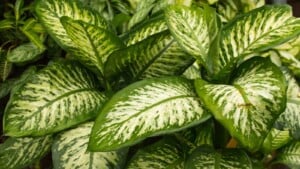Succulents have adapted to suit sunny, arid, and dry conditions by developing fleshy leaves and other water-storing structures. There are a hundred types of succulents to choose from, from common varieties like Aloe Vera and Jade Plant to non typical species such as Donkey Tail and Chocolate Soldier Plant.
Most succulents are known for being non-demanding houseplants that do best in bright light and well-drained soil, as their roots are prone to root rot if they stand wet for too long. Here are ten popular succulent plants (both indoor and outdoor) that are easy to care for. Indoor succulents should be grown in a specially formulated potting mix for succulents or a light, fast, draining indoor potting mix.
Donkey’s Tail (Sedum Morganianum)

Native to Mexico and Honduras, Donkey’s Tail is a slow-growing indoor/outdoor succulent that has rows of teardrop-shaped, fleshy, blue-green leaves and makes an excellent choice for hanging indoor plants. This succulent has low water need but requires complete to partial sun. Donkey’s Tail can reach trailing lengths of up to 4 feet, but it grows about 24 inches on average.
String of Pearls (Senecio rowleyanus)

Though this succulent is typically cultivated worldwide and year-round as a hanging plant, String of Pearl plants are terrestrial and groundcovers in its East African natural desert habitat. This succulent can be planted anytime but will thrive best in warmer months.
This succulent can grow indoors or outdoors and is often grown as a hanging plant. A string of Pearls has dangling stems and round leaves that can reach 3 to 5 feet long. This unique succulent has low water needs but needs full to partial sun and sandy, well-drained soil.
Silver Dollar Plant (Crassula arborescens)

Silver Dollar Plant is a multi-stemmed indoor Crassula species shrub that can grow up to 4 feet tall. Native to Asia and Europe, this succulent is actually part of the Brassicaceae family, which makes it a relative of foods like Brussels sprouts and broccoli. This succulent has rounded blue-grayish leaves with outstanding maroon edges. This popular succulent requires bright indirect light, and it is toxic to pets.
Chocolate Soldier Plant (Kalanchoe tomentosa)

Also commonly known as panda plants, Chocolate soldier plants are extremely houseplants because they’re low maintenance, easy to care for, attractive, and cute. This indoor/outdoor succulent has pale green leaves covered with grayish-white fuzz and a brown chocolate spotted edge and can grow up to 2 feet tall. Chocolate Soldier Plant’s water needs are low and require bright indirect light to thrive. Be careful if you choose this succulent as your next houseplant, as it is toxic to pets.
Snake Plant (Dracaena trifasciata)

This hardy succulent is an excellent choice for beginners due to its growing conditions, broad tolerance, and also ideal container plant to add vertical interest to indoor gardens. The snake plant is often referred to as a nearly indestructible houseplant thanks to its stiff sword-like leaves. This succulent is a slow grower and can reach up to 8 feet in height if grown in its ideal conditions (indirect light and some direct sun). Snake plants are toxic for pets.
Ghost Plant (Graptopetalum Paraguayense)

In warm conditions, this low-growing succulent can be grown outdoors. Otherwise, it should be potter as a houseplant. Ghost Plants have whitefish grey pointed leaves and a unique trailing rosette-like form, 6-12 inches in height. The rosettes take a pinkish-yellow tone or a blue-gray hue in full sun in partial shade. This succulent thrives in full to partial sun and in sandy, well-drained soil. This slow-growing succulent is normally purchased as a small potted plant, but it is usually planted in spring when grown outdoors.
Flapjack (Kalanchoe Luciae)

Because of the clam or paddle-like shape of its leaves, Flapjack is also known as the paddle plant. This succulent can be grown outdoors or indoors, reaching 1 to 2 feet in height and spreading in rosette clusters of 2 to 3 feet. Flapjacks thrive in loamy, sandy, well-drained soil, are full to partial sun, have low water needs, and are toxic to pets. Flapjacks work well for rock gardens or xeriscape landscapes in drought-prone regions.
Aloe Vera (Aloe Barbadensis Miller)

Aloe Vera has been grown for thousands of years, and it is one of the most recognizable and popular houseplants, mainly for its medicinal properties. This plant is native to Africa and sports gorgeous thick leaves in a rosette form. While it is mainly seen as a houseplant, this succulent can also be grown outdoors in warmer zones.
Even though it may take years for Aloe Vera to develop its spiky flowers, the fleshy lace-like shaped leaves with jagged edges make this succulent an attractive indoor or outdoor houseplant. Aloe Vera grows 12-36 inches tall and requires bright natural light and regular watering (except during dormancy). This plant is toxic to pets.
Jade Plant (Crassula Ovata)

Jade Plant’s tiny tree-like appearance makes it popular and visually appealing as a decorative houseplant. This succulent has a long life and is often passed down from generation to generation. Jade Plants adapt to dry and warm conditions found in most homes.
Jade plant has fleshy oval-shaped leaves and thick woody stems which resemble mini tree trunks, and it grows slowly -around 2 inches per year- and can reach up to 3 and 6 feet in height. Jade plants have moderate water needs, require bright indirect sunlight, and can be toxic to pets.
Mexican Snowball (Echeveria Elegans)

As its name suggests, this succulent is native to Mexico and can be commonly found in warm semi-desert habitats across the country. Mexican snowballs are one of the most recognized varieties of Echeveria succulents, and it has rosette-like shapes and thick fleshy blue-greenish to silvery green leaves. Mexican snowball succulents can be grown as garden plants or houseplants, growing up to 8 inches in height. This succulent has low water needs but requires full sun and sandy, well-drained soil.
Avoid a Pathetic Garden by Following These 12 Gardening Tips

Have you decided it’s time to dive into the beautiful world of vegetable gardening? Prepare yourself for a fulfilling and successful journey using these 12 essential tips and tricks for your garden. Learn the secrets of planting in intervals, selecting suitable crops for your geographical zone, using the power of sunlight to enrich your harvest, and more.
10 Beautiful Outdoor Plants That Are Impossible To Kill

Thanks to the expertise of garden professionals, numerous plants have been found to grow and thrive in climates believed to be hopelessly barren. So whether your yard is drought-prone, shady, or has sandy soil, these hardy flowers and plants make a gorgeous addition to any garden.
10 of the Scariest Plants In the World According to Botanists

We all know about poison ivy and oak, but what are the real big baddies of the plant world? That’s what one plant-lover, or at least plant enthusiast, wants to know. They ask about the “scariest plants” in an online forum, and there are almost too many fascinating and terrifying answers for comfort.
12 Easy Vegetables to Grow at Home Even if You Have No Idea What You’re Doing

Homeowners are increasingly turning to palms for their landscaping needs. Learn about 20 of the most popular palm trees for homeowners here.
10 Plants You Should Absolutely Never Grow in Your Garden

Gardening is a pastime relished by many people. There’s something about planning and cultivating a garden and seeing your efforts come to fruition. It’s a gratifying feeling. Growing the wrong plant species can dampen the joy of that experience. Avoid these plants and flowers to have a garden you’ll always enjoy and be
This originally appeared on Planet Natural.











